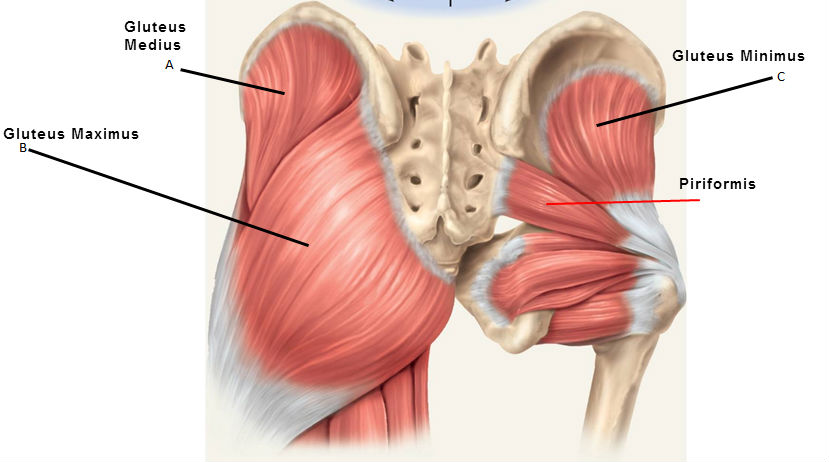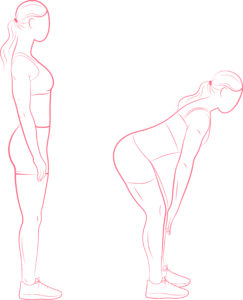Quick Intro
I recently decided to film my pre-workout glute activation routine with my PT, Carla Pryor. The extensive focus here is getting the glute max and glute med (Figure 1) fired up and ready to work.

Figure 1. The gluteus maximus (glute max) and gluteus medius (glute med).
Why would I care about this you might ask?
Simply put, if you care about not being in pain, and not being injured, this is for you. Conversely, if you like having knee pain, hip pain, and back pain, do NOT do any of these.
In all seriousness, I do this as part of my broader workout prep routine at least 3 times per week. It’s making a huge difference, but it takes time to get these right. One of the biggest mistakes we make, courtesy of all the sitting we do, is we fail to fire or load our glutes when we hip hinge (Figure 2).

Figure 2. Proper hip hinge. Neutral spine, knees slightly bent, bending at the hips (not the back).
Furthermore, even when we are strong on a front-to-back plane of motion, we tend to lack side-to-side (lateral) stability, which the glute med plays an important role in providing.
I tried to include a short description with some key reminders below each video link below, but even those won’t make much sense unless you’ve already listened to the instructions and pointers in the audio at least a few times.
Enjoy!
Intro

1 | The Bridge

The Bridge, which has 4 parts, will fire up your glutes.
- Key reminders:
- You should NOT feel like you’re arching your lower back
- Keep your heels in line with hips
- Both hips at the same level, one should not be higher than the other
- “Core” (in scare quotes because core doesn’t really mean much, per se, and actually refers to the pelvic floor, transversalis fascia, etc, but we’ll cover that in more detail later) should stay engaged
- You should feel this in your glutes >>> hamstrings (and not at all in your lumbar spine)
§
2 | The “Jane Fonda”

The aptly-named ‘Jane Fonda’ exercise puts the tension mainly in the gluteus medius. Credit for this exercise goes to speed guru Ryan Flaherty.
Key reminders:
- Heel out as far as possible (i.e., hips fully extended)
- Toes pointing down
- Careful not to load the lumbar spine
- If you feel this in your lateral quads (VLO), you are doing it incorrectly
3 | The Starfish

You’re guaranteed to feel it in your glute med if you do this one right. If you do this after the Jane Fonda you probably only need to do 5 reps per exercise per side.
Key reminders:
- Elbow on the ground should be in direct line with shoulder
- Engaged in your mid-back
- Lifted knee should be in line with hip
4 | The Dowel Squat/Lunge

This sequence is the link between the floor work and the standing work (in technical parlance, the link between “open chain” and “closed chain”). Very important for me to “feel” that I can lunge and squat without loading the lumbar spine and that I can “feel” my glutes/hamstrings doing the work, and keep my hips back.
Key reminders:
- For squat portion
- Pretty narrow stance—feet under your shoulders (not wide like a power squatter)
- Avoid a knee valgus (knees collapsing inward as you squat)
- Knees should be over ball of foot and never in front of toes
- For lunge portion
- Lumbar spine stays neutral throughout the movement, which means there should no flaring of the ribs
- Shorter and narrower stance than you initially find comfortable
- Rear heel straight up
- Same caveat for front knee in relation to front foot
- Sink straight down so that you’re eccentrically loading your quads in rear leg and glute in front leg—if you do this exercise correctly, even without much weight, you will likely fail in the front glute
5 | The Shark Bite

My all-time favorite, I called this “The Shark Bite” after Carla started me on it in early 2018 when I imagined this was what it might feel like to have a shark bite my glutes. If you do this correctly, your glutes are screaming by rep 10. This is the starter version.
Key reminders:
- Spine is neutral
- Hips level when bent forward (the tendency is to have non-planted hip rise—fight the urge)
- Avoid knee valgus on the planted leg
- Keep “core” (same quotes and caveat as above) engaged throughout all the moving and bending
Sink straight down when going into lunge and curtsy, with torso upright (the tendency is to lean forward in the curtsy)
6 | The Advanced Shark Bite

This is the more advanced “Shark Bite” for those masochists out there. This takes the basic version to a new level of glute activation.
Note: Do not start with this until you can “easily” do 10 reps of the standard shark bite *correctly*. Also, this is really unnecessary on a day when you will do significant glute work, given how much it will fatigue you. Instead, use this on days when you are not able to do more formal hip hinging.
Key reminders:
- Always sink straight down when going into lunge and curtsy, as it’s especially easy to lean forward with the dumbbells in your hands
- You should feel this is on your glute and hamstring and not the tendons behind your knees
What’s next?
Once you’ve completed this series you should be nice and ready to lift. If you do this routine at the beginning of the workout, DO NOT go to the point of fatigue. Only do it until you feel the appropriate muscles fire. If you do this at the end of the workout or a standalone workout, by all means, go for broke as long as you can hold your form.
Once you become a Zen master of this stuff, you may consider this routine:




